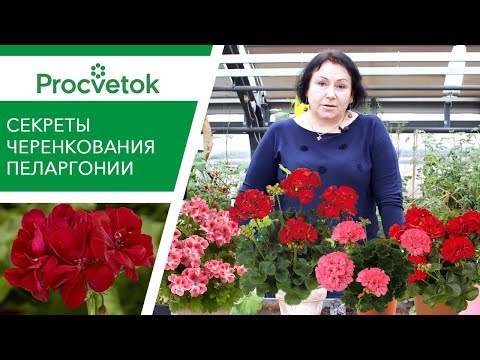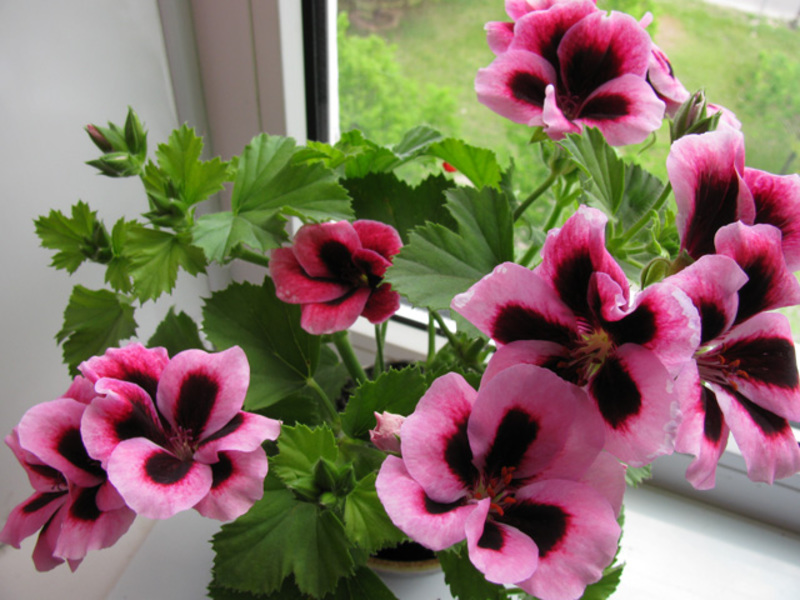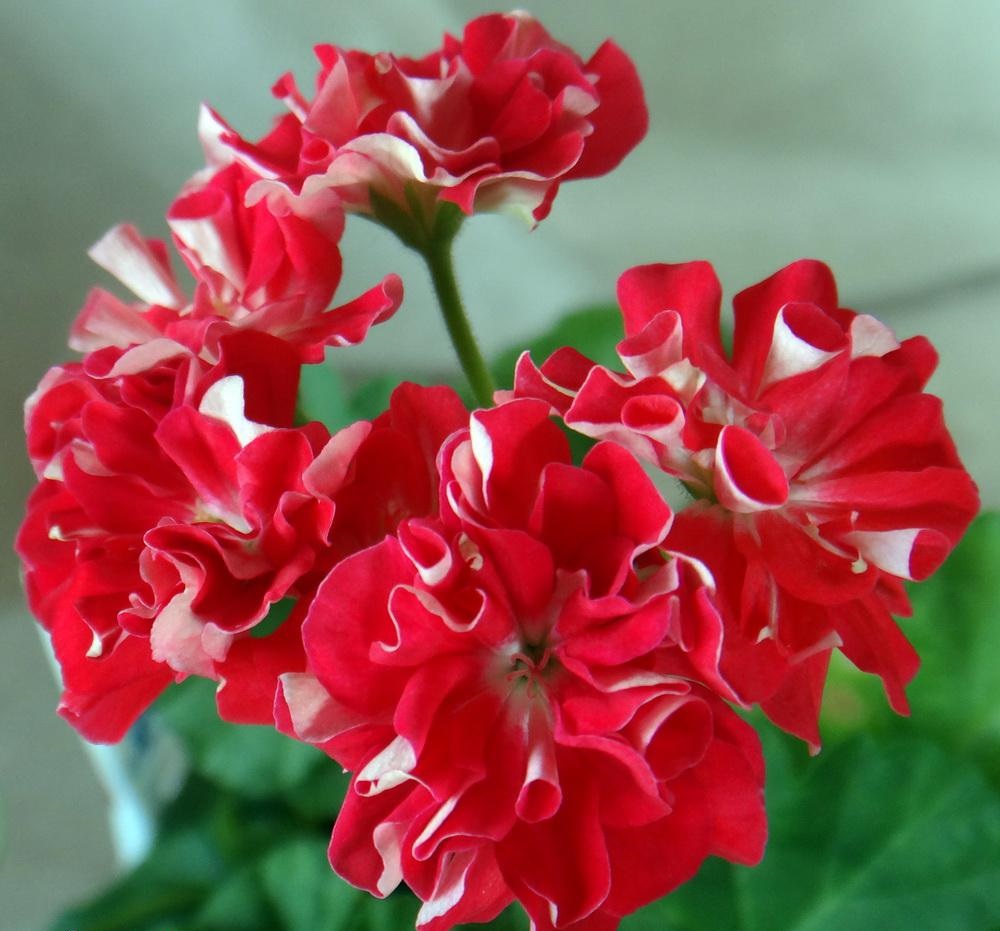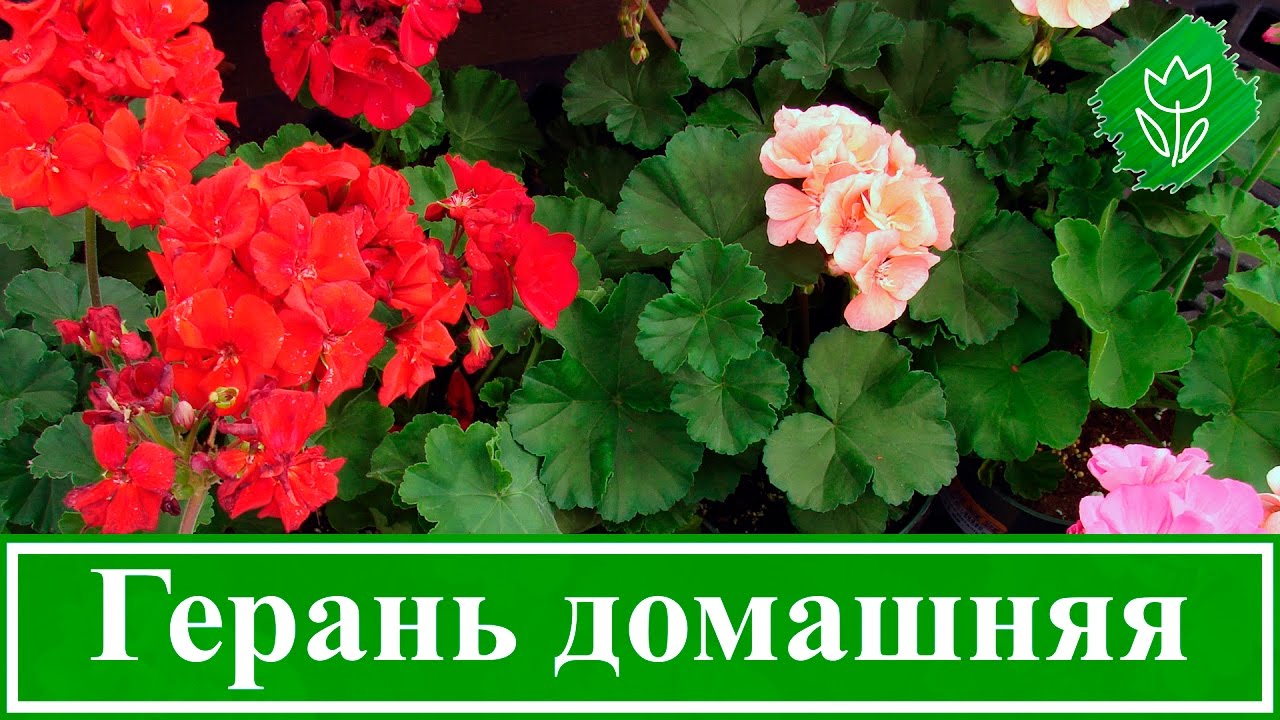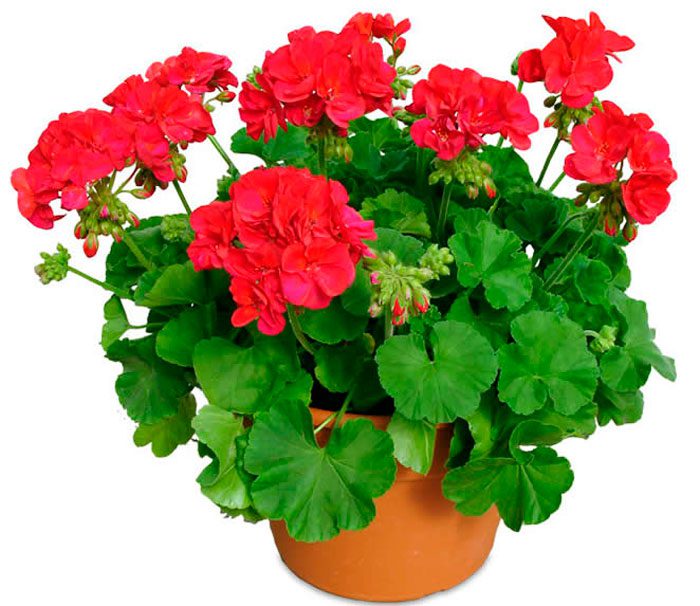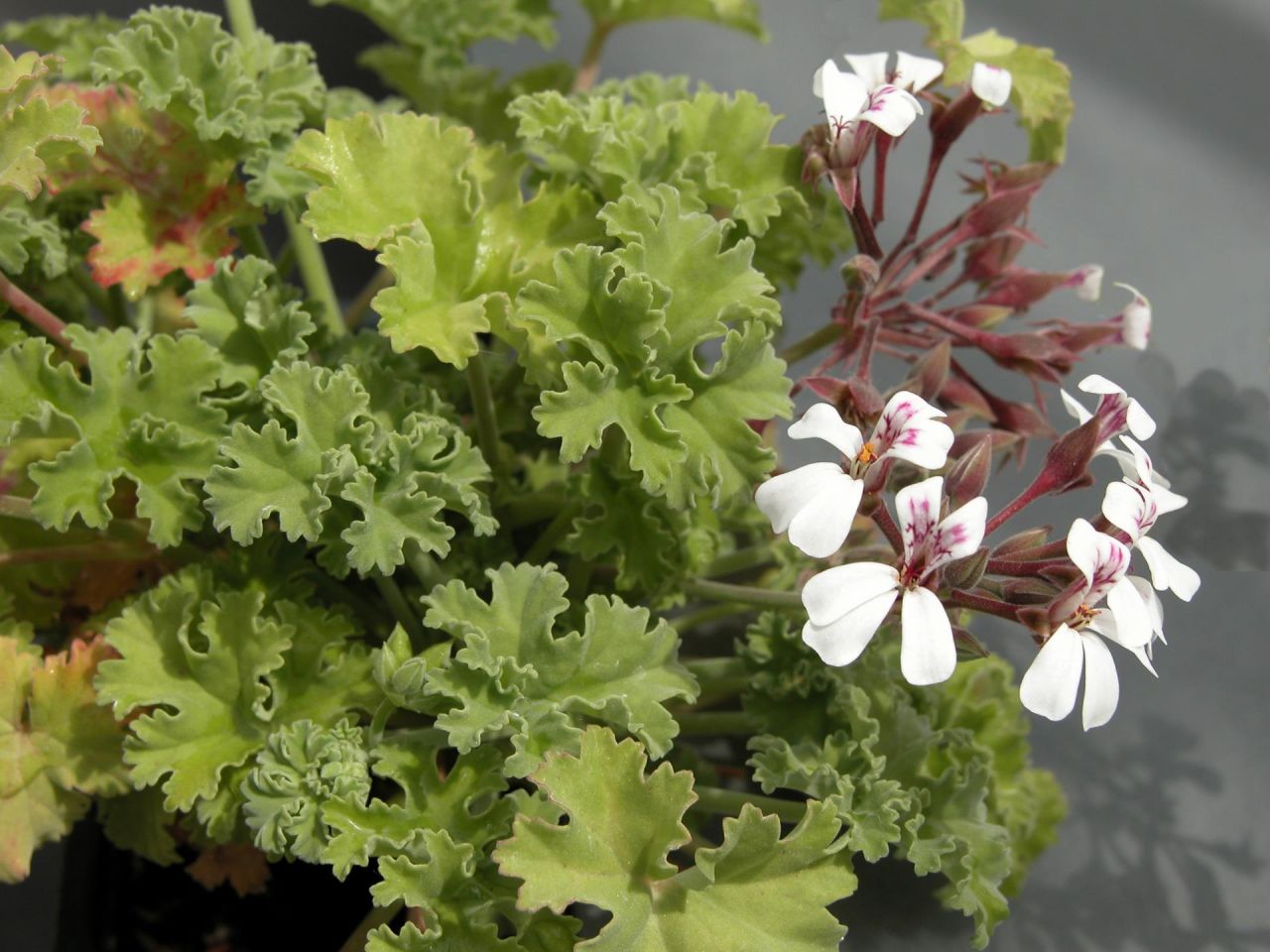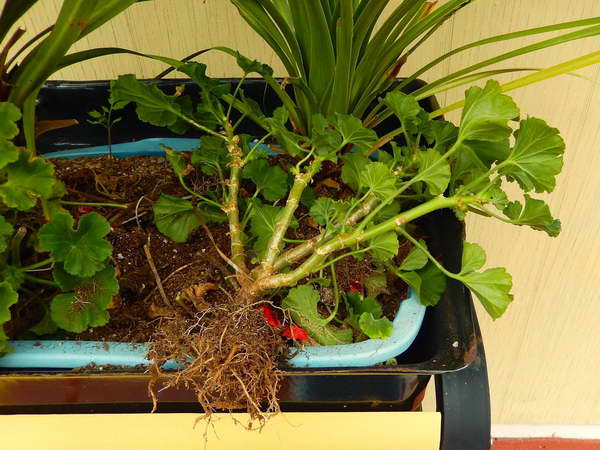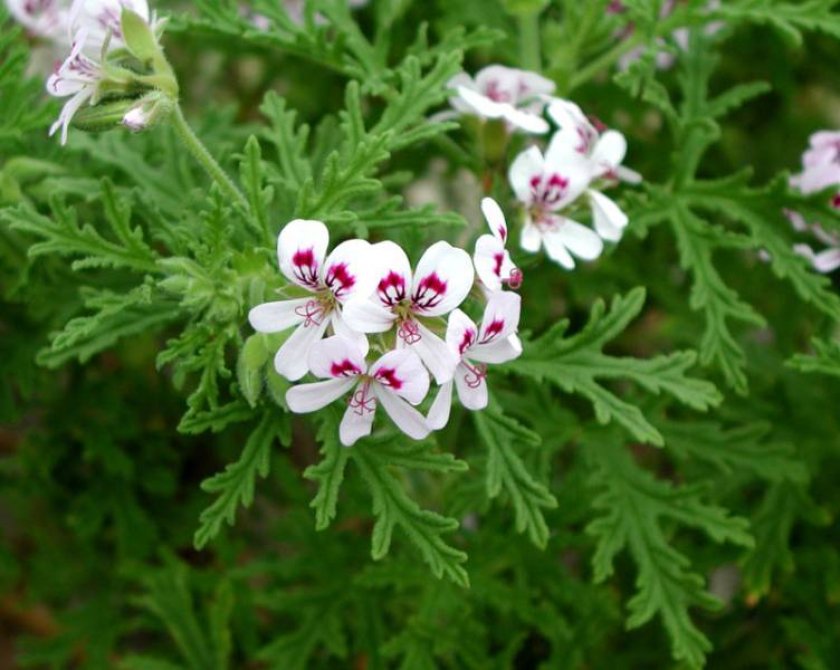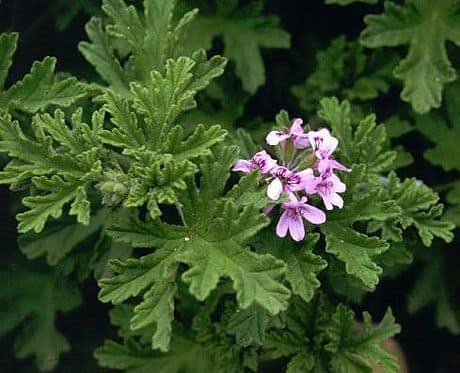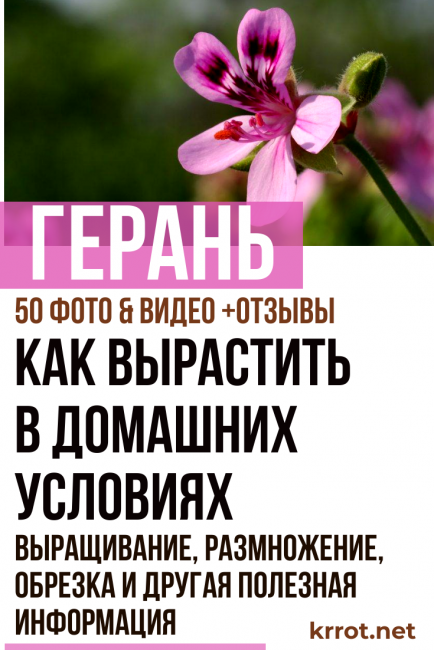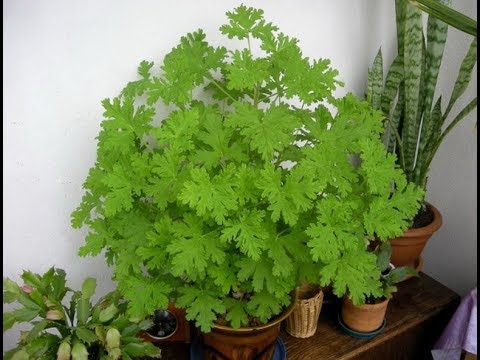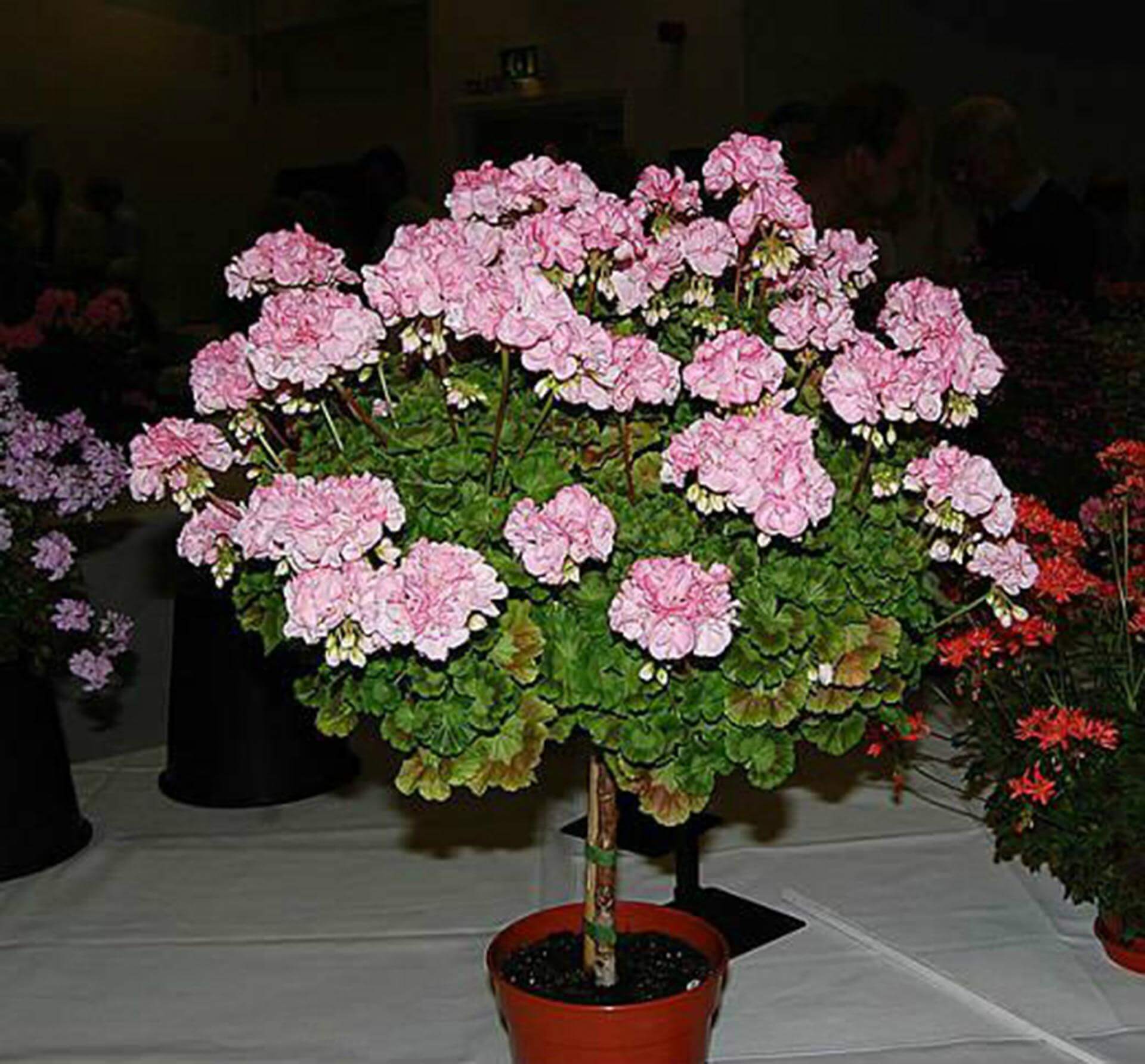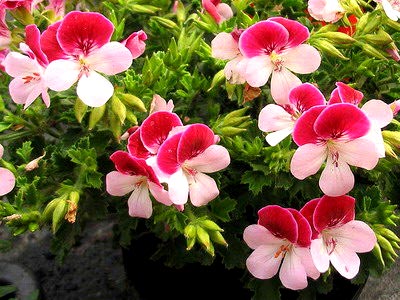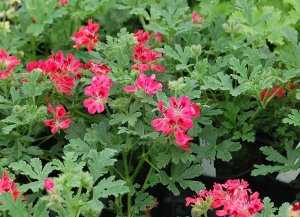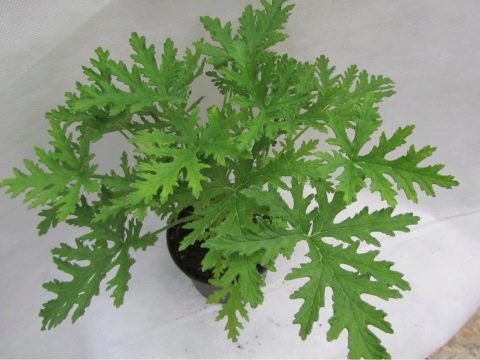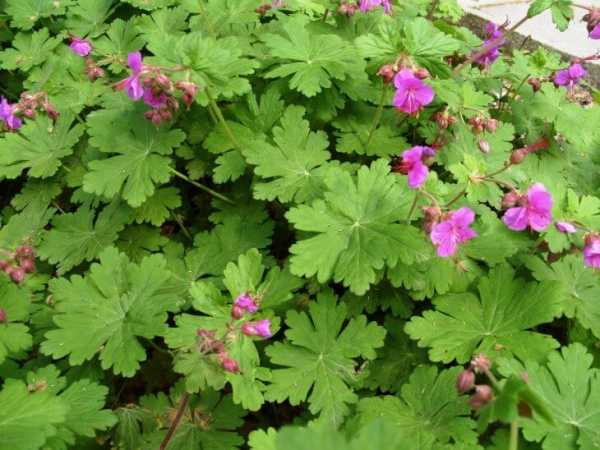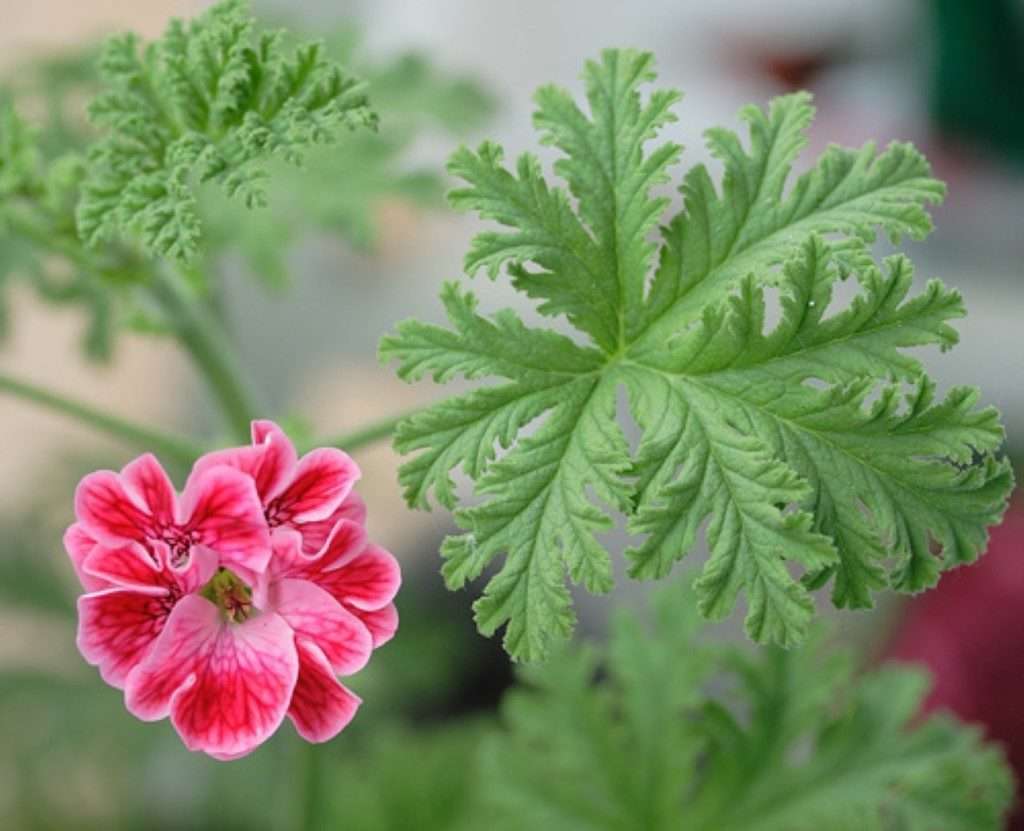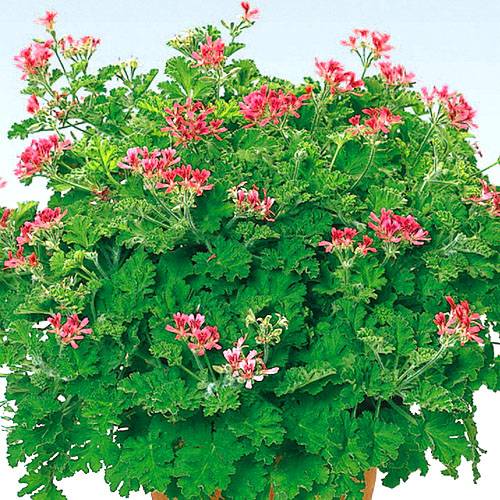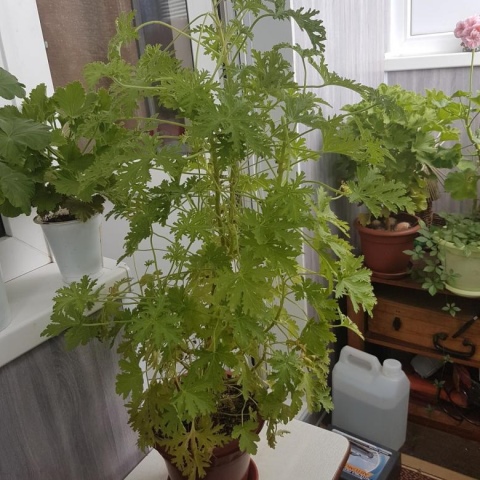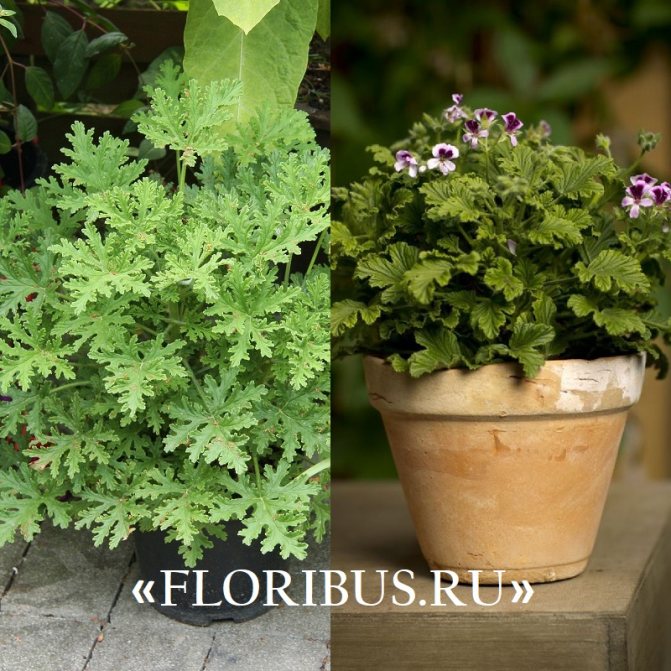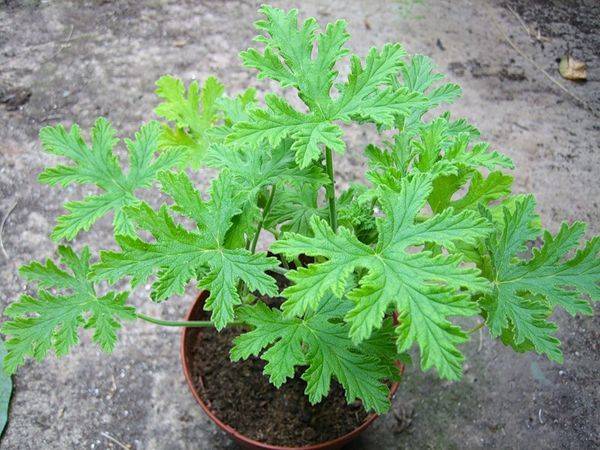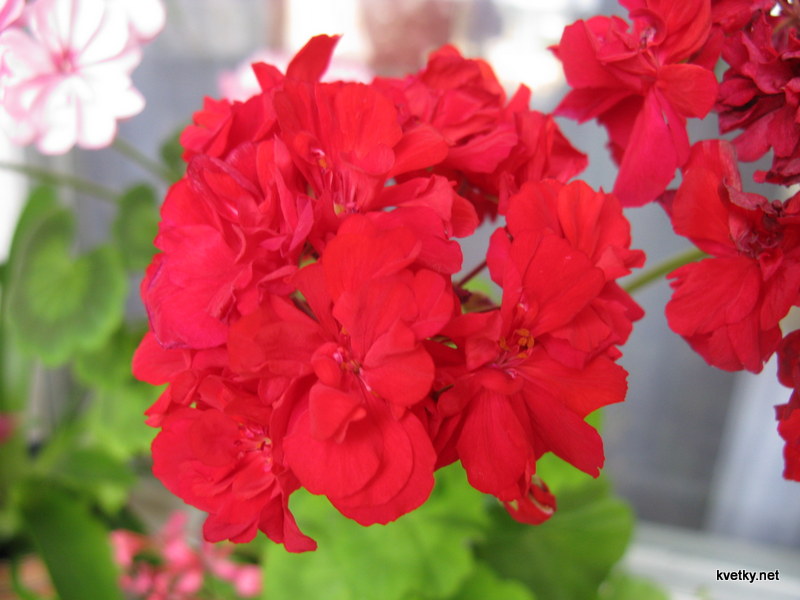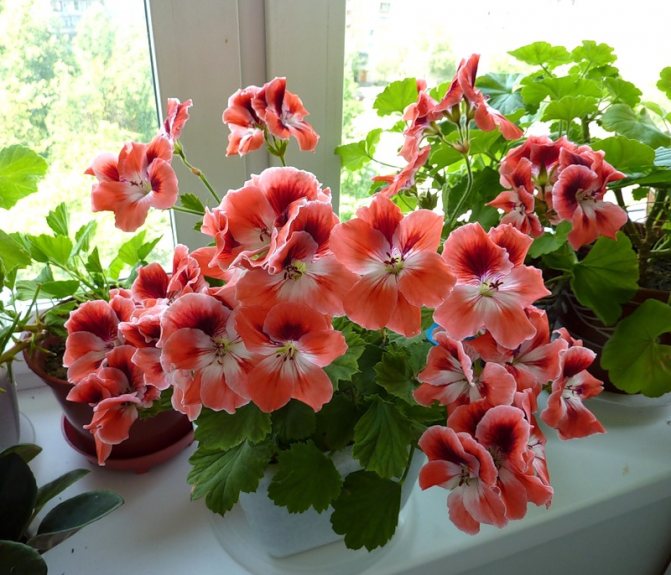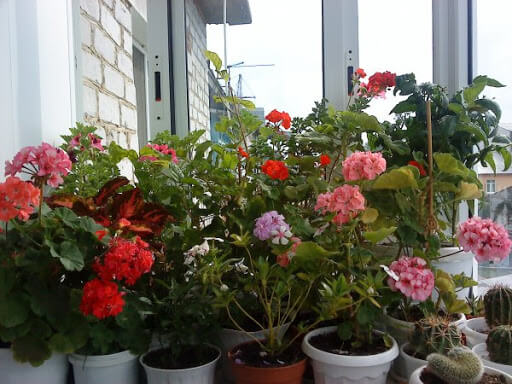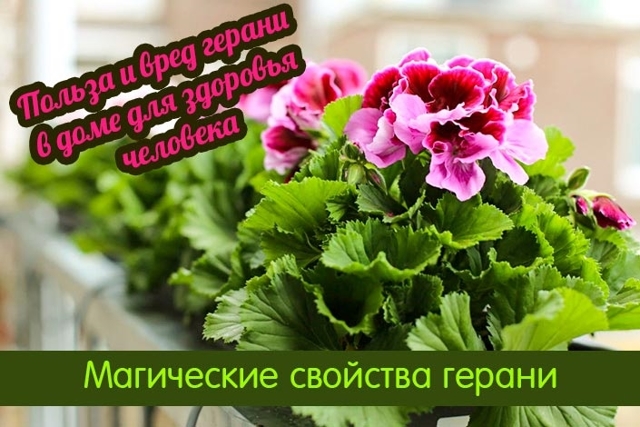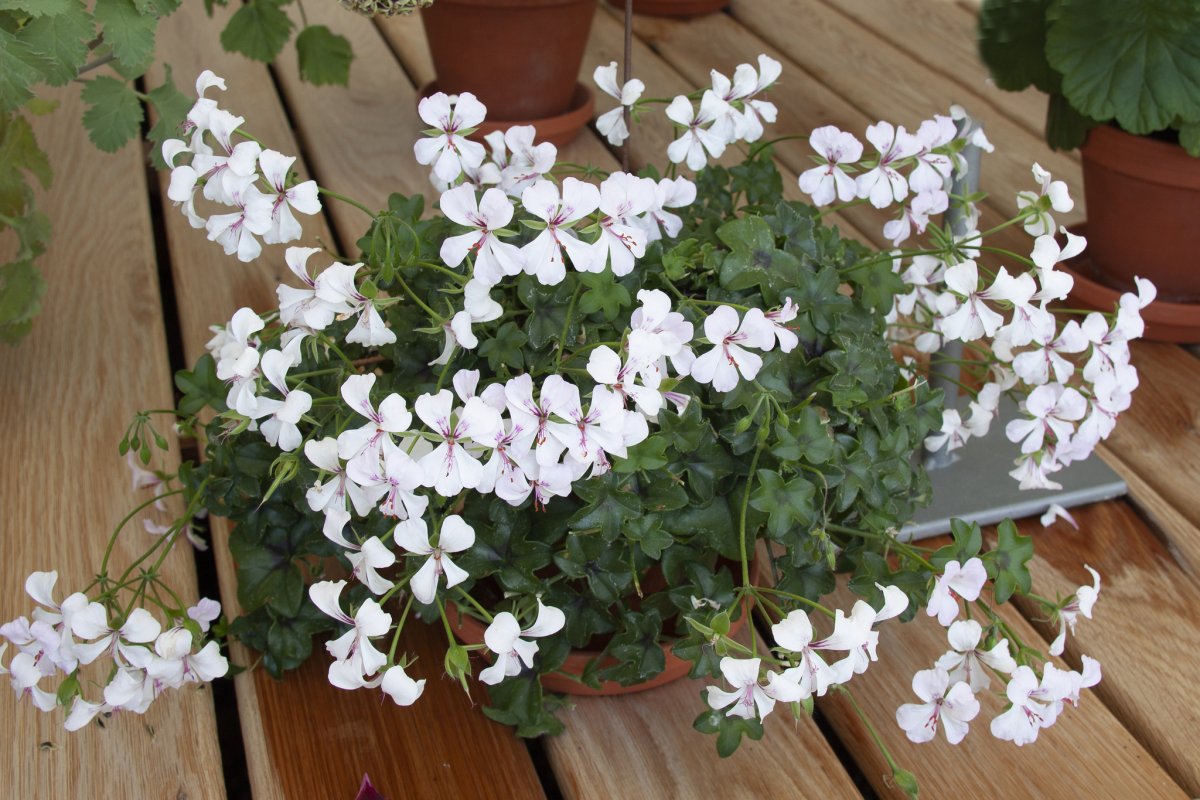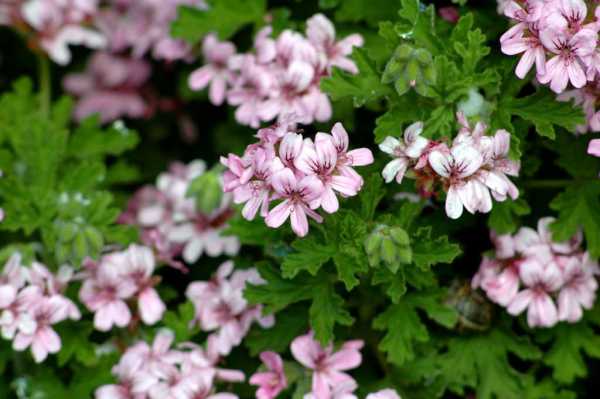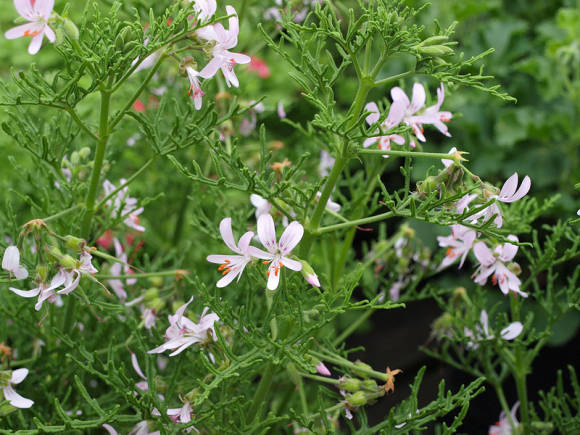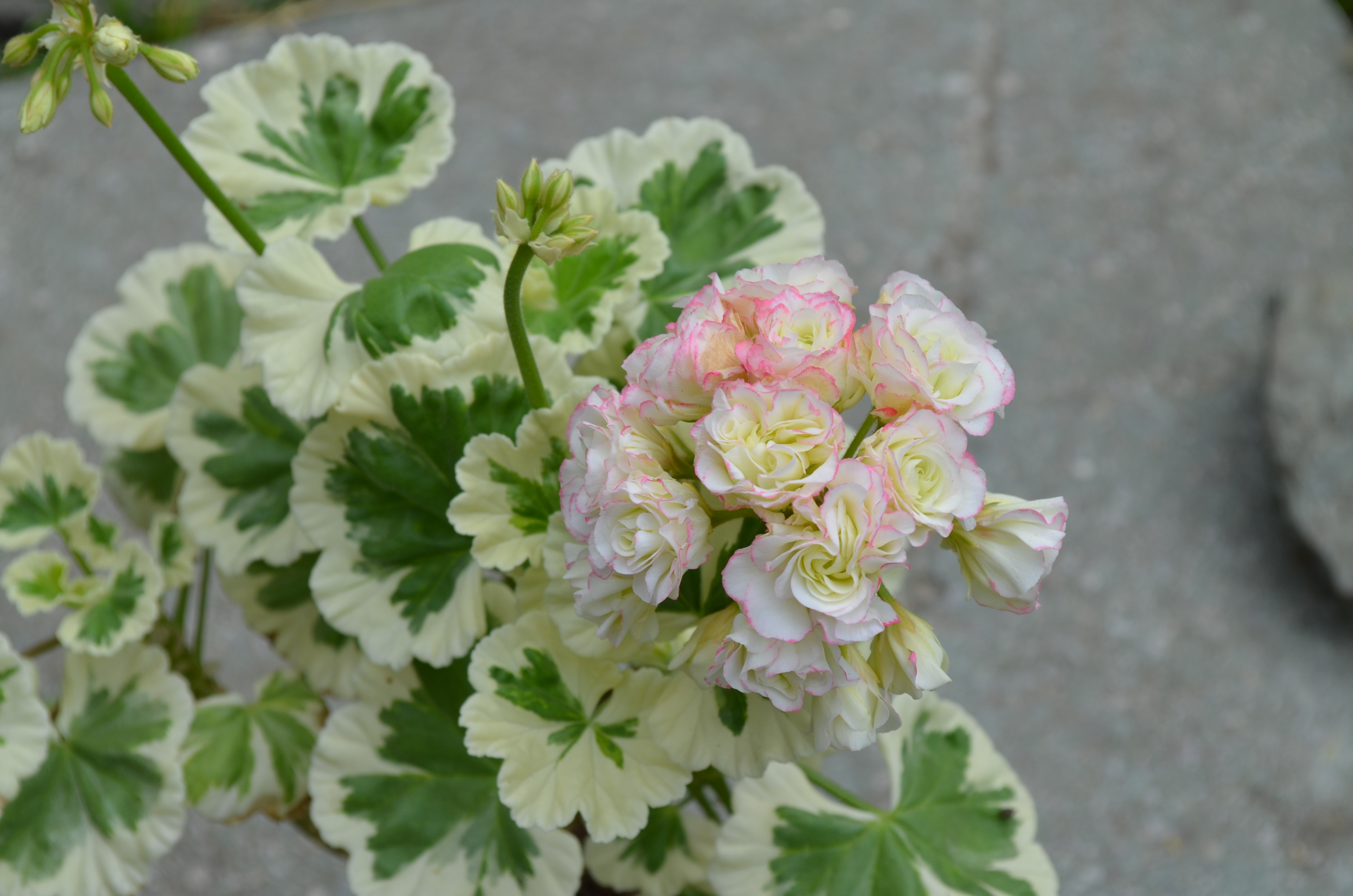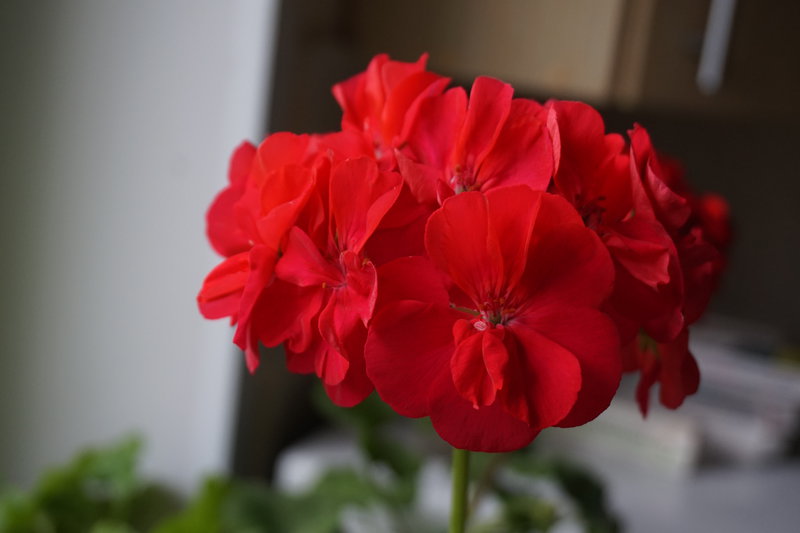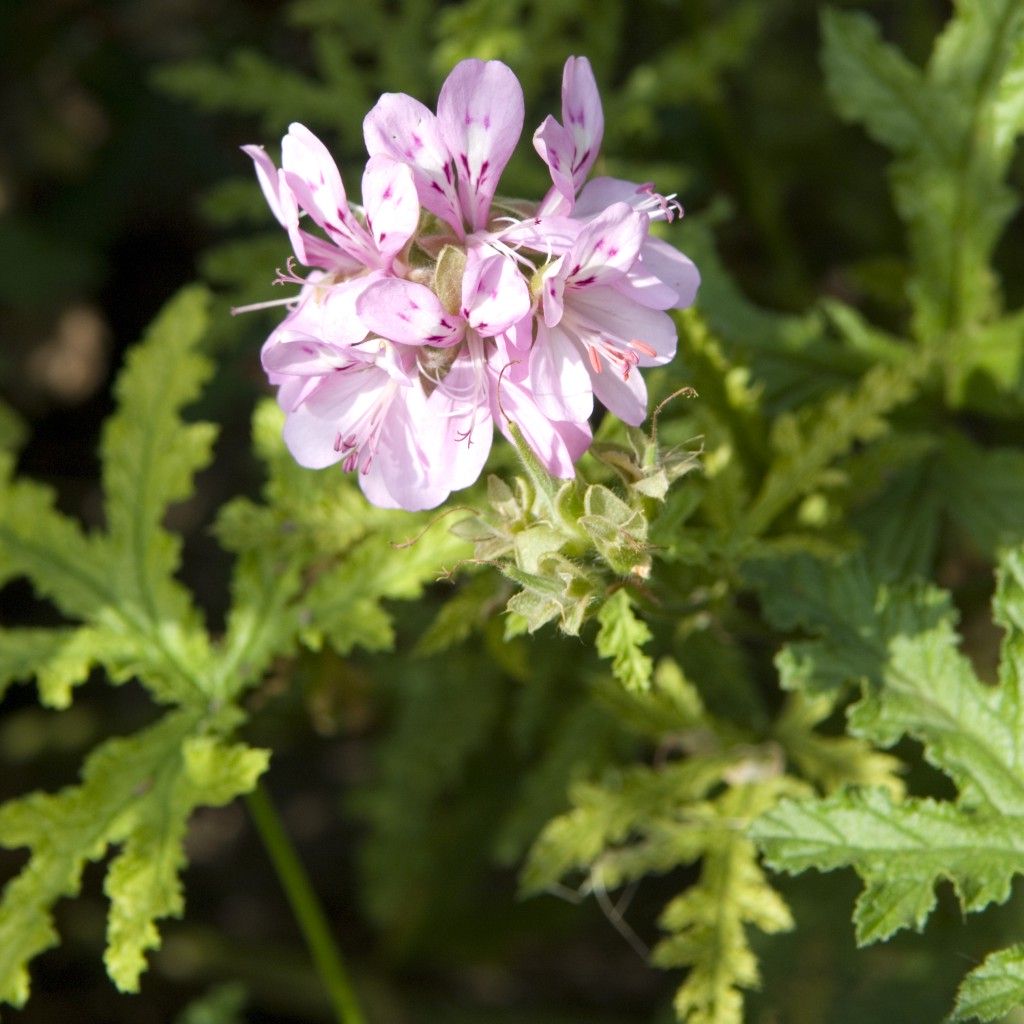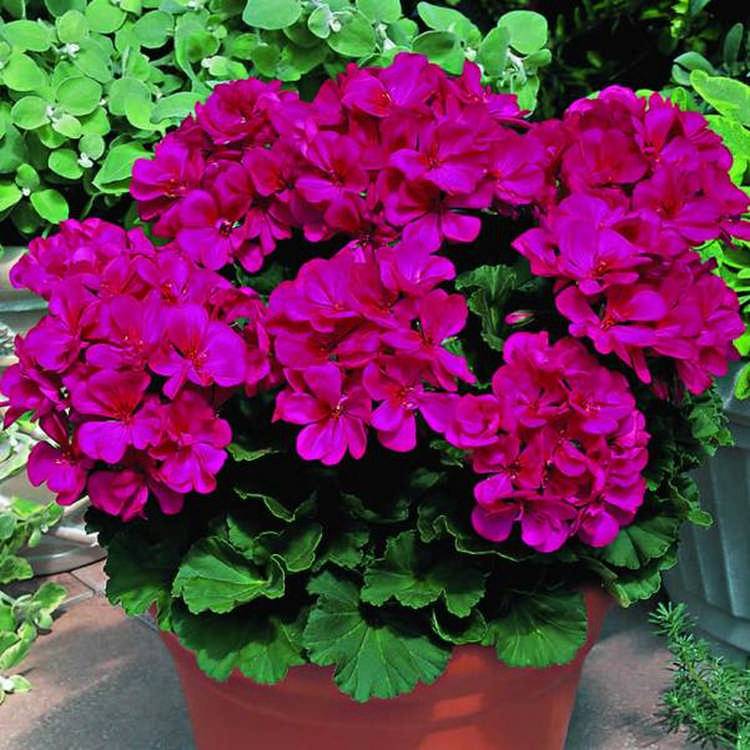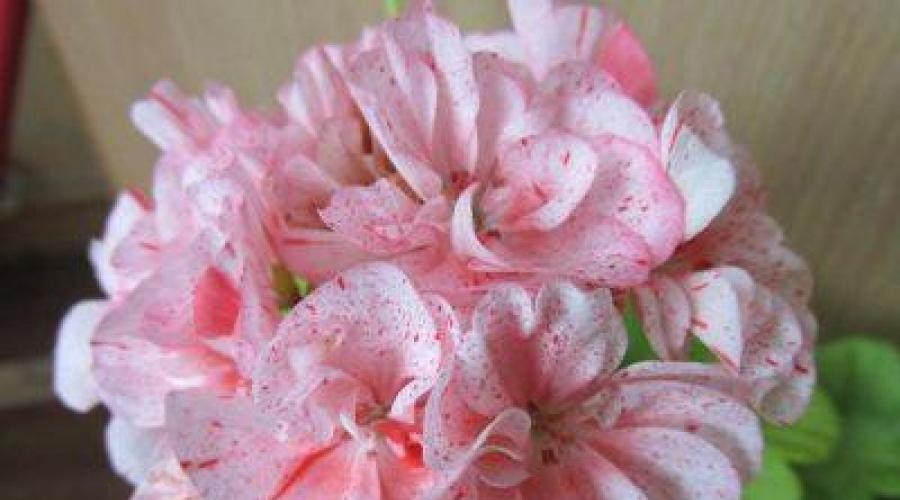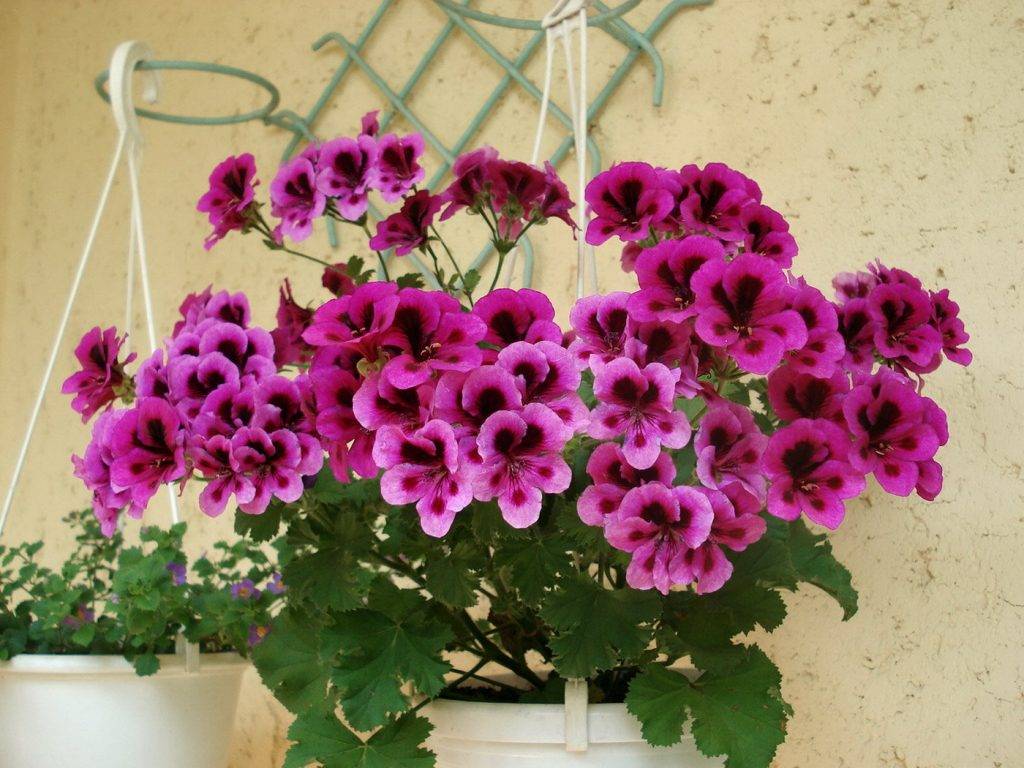Reproduction methods
There are several ways to breed pelargonium. Most often, at home, geraniums are propagated by dividing the bush and cuttings, but you can also use seeds. The process is more time consuming, but as a result, a large number of healthy young plants develop.
Reproduction by dividing the bush is best done in spring. A plant is suitable, the root system of which has completely filled the pot and is visible through the hole in the bottom of the pot. An adult bush is watered abundantly and taken out of the pot. The root system is carefully disassembled, if necessary, cut off with a sterile knife. Each part should have leaves and roots. Cutting points must be treated with activated carbon and cinnamon powder. After separation, the flowers are planted in small pots. Enough 10-14 centimeters in diameter. If the pot is too large, flowering will occur later or be postponed to the next year, until the plant fills the entire pot with roots. Drainage must be placed at the bottom of the pot. You can prepare the soil yourself or purchase it at the store. The soil from the store must be diluted with garden soil and disinfected. To do this, it is calcined in an oven or spilled with a solution of potassium permanganate.

Propagation by cuttings can be carried out throughout the year, but the best results will be from cuttings cut in the spring. During spring pruning, a large number of cuttings remain, which are easily rooted. The cut branch should have no more than 2-3 leaves. Very large leaves can be cut in half. The cut of the cutting is carried out at an angle, with a sharp knife or blade. It is better to disinfect it beforehand. The cuttings are left at room temperature for several hours until the cut winds up. Ready cuttings are placed in a glass of water. Better to wrap it in dark paper. In the dark, roots will form quickly. It is necessary to add a tablet of activated carbon to the water, and cut a cardboard with a hole in the diameter of the neck, into which to put the handle. It should not sink much in water, no more than 1 centimeter, otherwise it may start to rot. Pelargonium takes root easily if it is simply planted in the ground. For this, a regular plastic cup is suitable. Holes are made in it to drain the water, fine drainage and soil are poured. The ground should not be very wet, otherwise the plant will not take root, it will begin to rot. At first, the stalk is not watered, you can only slightly spray the ground. If it starts to wilt, cover with a jar.
Seed propagation is a long and painstaking process. Before planting, the seeds must be processed. To do this, they are lightly rubbed on fine sandpaper and soaked in a stimulator for 3 hours. Then they are soaked in clean water for another 3 hours. The soil from the store is oversaturated with nutrients, so it's best to compose it yourself. It should include peat, river sand and sod land in a ratio of 1: 1: 2. The container for the first planting of seeds should be shallow. Seeds are evenly distributed over the surface at a distance of 5 centimeters from each other. Spray from a fine spray, if the ground was dry, cover the container with glass. Seedlings will appear within a month. After 3-4 leaves appear, they can be transplanted into separate cups or immediately into small pots.
The process and features of flowering
Geranium is a houseplant that does not take a lot of time and effort to care for. She needs special care during flowering. As soon as the ovary appears, it is assessed whether anything will interfere with the formation of inflorescences.
Why is it important? For example, leaving the pots to be "torn apart" by direct sunlight, the flowers will not be bright. In other words, a blooming geranium will turn into a weed without taking into account the features from the list below.
- In winter, they provide coolness to the plant. The main thing is to know when to stop in everything: t air in a room below 10 ° C is unlikely to be a good thing, contributing to its premature awakening from a state of rest.
- The "South" window is a great place to place the pelargonium pots. She adores the sun, but not in abundance.
- Light and nutrition are two prerequisites for growers who want to enjoy blooming all year round.
- The more branches, the more places to bloom. The shoots are pinched to enhance branching.
- As soon as the flowers wither, remove them.
- Pelargonium rejuvenates and gains the strength to grow with regular pruning.
If the geranium is grown from seed, it will bloom 130-140 days after sowing. This will happen when the plant has gained good vegetative mass.
On a note. Many gardeners sow geraniums in pots in early February in order to enjoy the beauty of a flowering plant in May.
How long will flowering last? How many buds will appear? If you do not follow the geranium, do not feed it or apply fertilizers rich in nitrogen, it will not bloom for 130-140 days. Everything will happen with a delay, and besides, there will be few flowers. This process will be influenced by factors: lighting, watering, temperature conditions.
When the amount of phytohormones is sufficient, the bud of flowers will be laid. Soon, exogenous outgrowths will appear on the growth cone of the shoot. Sepals will form, then petals.
After the formation of the anther and filament, stamens will develop. Carpels look like corymbose leaves with short stalks. Their lower side grows more intensively than the upper one, as a result of which a cavity with accrete edges is formed.
In the upper part of the carpel, a column and stigma are formed. These processes take place inside the kidney.
After the flower is developed, pollination should take place. For this, the parts of the plant participating in this process must become free and accessible. It happens in different ways.
If you bring the pot of geraniums out into the open air, the insects will pollinate the flowers. Self-pollination or artificial pollination can also occur. As soon as it happens, the petals and stamens, stylodies and stigmas will fall off.
The calyx will be preserved, as it is needed to protect the ovary, which will then turn into a fetus. The duration of flowering of one flower is 3-10 days, and in one their inflorescences up to 50 pieces.
Read about what to do with faded flowers and whether you need to cut geraniums in our material.
Where and how to plant it?
Indoor geranium is considered a non-capricious flower (learn all about the types and varieties of indoor geranium here). Despite the fact that it is a native of warm countries, it easily tolerates cold temperate winters. The most suitable place for a plant is a spacious room with plenty of light and fresh air.
Herbalists advise placing the flower in the bedroom as Pelargonium graveolens improves sleep. It also cleans the air well from germs and unpleasant odors, so the second option for location will be the kitchen. In summer, the flower can be taken outside, but hidden under a canopy from direct sunlight.
For the full development of geraniums, it is important to choose the right pot. For an adult plant, a suitable size of 20-25 cm in diameter and 3-4 cm in height
It is preferable to choose clay as the material for the planting container. In a plastic pot, the root system decays. The capacity should be renewed as the plant grows. If there is not enough space for the flower, then it begins to die.
Lighting and location
Lemon geranium is a light-loving flower, but it can grow even with little light in the back of the room.She will immediately make it clear to the owner with her appearance about the lack of lighting. If there is little light, the leaves will turn light green. The plant itself will stretch upward, the shoots will be thin and long. To correct the situation, you need to put the flower in the sun for about 6 hours. This is how much time per day geraniums need for full growth.
In the room, geraniums are best placed on the windowsills on the west or east side. At the same time, the place must be completely protected from possible drafts. It is not recommended to place the flower under a stream of hot or cold air, that is, directly near heating appliances or under an air conditioner.
To stimulate flowering, you need to use additional artificial lighting.
Soil requirements
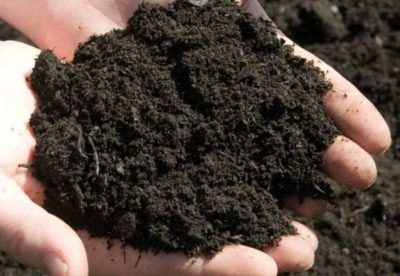
For planting and transplanting lemon geraniums, choose a special or universal soil
The following components, taken in equal proportions, are considered the optimal composition for geraniums:
- coarsely fractional river sand;
- peat;
- charcoal;
- humus;
- sod land.
Soil acidity plays an equally important role in the further growth of Pelargonium graveolens. She does not tolerate a drop in pH to 5.5, in which case she stops eating. The ideal acidity ratio is considered to be pH 6.5. The soil should be neutral or slightly acidic.
Home care
Consider the basic recommendations for caring for this miniature plant.
Watering
It is necessary to provide moisture to this plant regularly and in sufficient quantities. In summer it is better to water every other day, and in winter the number of waterings should be reduced to once a week. It is not recommended to allow excessive moisture: the soil must be dry before the next watering.
Thoroughly loosen the soil after each watering, since regular and sufficient access of oxygen to the roots is very important for dwarf pelargonium.
Dwarf pelargonium does not need spraying: this procedure can only damage its foliage and flowers.
Top dressing
The plant needs regular additional nutrition throughout the growing season from March-April to October-November. In winter, dwarf pelargonium is not fed, giving it time to rest.
The plant especially needs phosphorus and potassium, but you need to be careful with nitrogen: with an overabundance of this trace element, the green mass of dwarf pelargonium actively grows, but the flowers are in no hurry to form.
Advice! It is recommended to use a complex fertilizer for pelargonium: all components in this composition are selected in the best and most optimal way. The frequency of fertilization is once every couple of weeks.
Molding
In order for the bush to please the eye with its splendor, it is necessary to regularly pinch young shoots. This measure will allow the plant to form a larger number of lateral branches, and its overall decorative effect will thus only benefit. Additionally, we note that in order to form a dense compact bush of a good shape, it is recommended to grow dwarf pelargonium in spacious containers, although in close ones it will bloom better.
It happens that during the winter some shoots stretch quite strongly, compared to others. With the onset of spring, such "lively" specimens are recommended to be shortened by a third of their growth. If the cuttings cut during molding are healthy and strong, they may well be rooted. Thus, more beautiful graceful pelargoniums will be added to your household.
Medicinal properties and application
The air in the house where fragrant geranium grows is filled with phytoncides and essential substances that have a calming effect on the state of people. Geranium is an excellent antiseptic. The healing properties of this species are truly inexhaustible:
- healing aroma relieves fatigue, irritability and normalizes sleep;
- a compress of crushed leaves relieves lumbar and joint pain;
- concentrated geranium juice helps to heal wounds and ulcers on the skin;
- medicinal infusions and decoctions have an effective anti-inflammatory effect for otitis media, tonsillitis, inflammation of the intestines and stomach;
- the smell of geranium has antidepressant properties.
What does a fragrant houseplant look like?
Scented geranium is a raw material for the production of geranium oil, which is widely used in the perfumery, cooking and cosmetology industries. In everyday life, aroma lamps with geranium oil are widely used. In addition, the crushed leaves are added to tea blends and fruit desserts.
Despite the unique medicinal properties of geranium, preparations based on geranium raw materials have some contraindications, namely:
- pregnancy, childhood;
- allergic reactions, individual immunity;
- stomach ulcer, gastritis, hypotension.
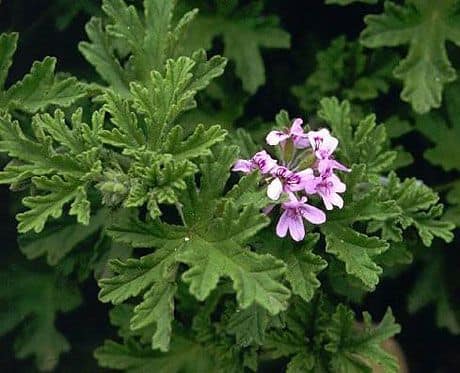
Fragrant geranium is a really amazing plant, it is considered a talisman of the house and a keeper of the family hearth. In a house with this plant, special psychological comfort and a cozy atmosphere are established.
Description of the lemon geranium plant
Pelargonium is one of the species in the Geramiaceae family. Scented pelargonium is often referred to as the smelling geranium. The confusion in the names occurs because the plants have a very similar leafy part, and they are all identified in the same family.
Geranium is called a plant called Herb Robert, and also cranes-bill because of the shape of the fruit of the seed box or storks-bill for its resemblance to the beak of a bird.

Lat. Geranium (photo)
Pelargonium leaves have a very distinctive appearance. They have beautiful, sometimes deep cuts, their curved shape resembles a frill ruffle.
The color spectrum of their deciduous part is from light green to dark green, and the leaves of some species have cream, red and even purple colors. The plant reaches a height of 30 to 80 cm.
The family of geraniums from the genus Pelargonium has more than 200 species. Among them, the five most common types can be distinguished, these are:
- decorative deciduous;
- ivy or balcony;
- fragrant;
- English, they are noble;
- zonal (standing).
You can also pay attention to the sixth type - these are succulent pelargoniums, they have fleshy stems and an original appearance, for which they are often used in ikebana and bonsai compositions. In the described flower, the leaves are oblong, lush due to their dissection, have a bright green color
With proper care, the plant grows up to half a meter in height, sometimes even taller
In the described flower, the leaves are oblong, lush due to their dissection, have a bright green color. With proper care, the plant grows up to half a meter in height, sometimes even taller.
But it is believed that the decorative function is better performed by a young flower, while the trunks of the plant are not yet lignified. Such a plant looks very fresh and delicate.
Lemon geranium got its name because of the aroma that it exudes at every slightest touch. What does this geranium smell like? The fragrance of this plant is reminiscent of the fresh and sparkling scent of lemon. Such geranium is the most fragrant houseplant.
Where and how to plant it?
Indoor geranium is considered a non-capricious flower (learn all about the types and varieties of indoor geranium here). Despite the fact that it is a native of warm countries, it easily tolerates cold temperate winters. The most suitable place for a plant is a spacious room with plenty of light and fresh air.
Herbalists advise placing the flower in the bedroom as Pelargonium graveolens improves sleep. It also cleans the air well from germs and unpleasant odors, so the second option for location will be the kitchen. In summer, the flower can be taken outside, but hidden under a canopy from direct sunlight.
For the full development of geraniums, it is important to choose the right pot. For an adult plant, a suitable size of 20-25 cm in diameter and 3-4 cm in height
It is preferable to choose clay as the material for the planting container. In a plastic pot, the root system decays. The capacity should be renewed as the plant grows. If there is not enough space for the flower, then it begins to die.
Lighting and location
Lemon geranium is a light-loving flower, but it can grow even with little light in the back of the room. She will immediately make it clear to the owner with her appearance about the lack of lighting. If there is little light, the leaves will turn light green. The plant itself will stretch upward, the shoots will be thin and long. To correct the situation, you need to put the flower in the sun for about 6 hours. This is how much time per day geraniums need for full growth.
In the room, geraniums are best placed on the windowsills on the west or east side. At the same time, the place must be completely protected from possible drafts. It is not recommended to place the flower under a stream of hot or cold air, that is, directly near heating appliances or under an air conditioner.
To stimulate flowering, you need to use additional artificial lighting.
Soil requirements

For planting and transplanting lemon geraniums, choose a special or universal soil
The following components, taken in equal proportions, are considered the optimal composition for geraniums:
- coarsely fractional river sand;
- peat;
- charcoal;
- humus;
- sod land.
Soil acidity plays an equally important role in the further growth of Pelargonium graveolens. She does not tolerate a drop in pH to 5.5, in which case she stops eating. The ideal acidity ratio is considered to be pH 6.5. The soil should be neutral or slightly acidic.
1. Seven Secrets of Success:
| 1. Growing temperature: all year long can be grown at temperatures between 18 and 25 ° C. During the winter months, you can provide a cool dormant period at a temperature of 7-13 ° C, so that the plant does not suffer from insufficient light. |
| 2. Lighting: brightly lit location with access to direct sunlight during the morning and evening. |
| 3. Watering and Humidity: Water regularly throughout the year, slightly drying the soil surface between waterings. It is better to increase the air humidity. |
| 4. Pruning: the plant needs regular pruning of young shoots and timely removal of aging yellow leaves. |
| 5. Soil: preferably rich in organic matter, light, nutritious, with good drainage. |
| 6. Top dressing: 2 times a month, with mineral fertilizers in spring and summer. When kept warm, they are also fed in winter, reducing the frequency of watering to 1 time per month. |
| 7. Reproduction: easily propagates by apical and stem cuttings in spring and summer, less often by sowing seeds in spring. |
Botanical name: Pelargonium graveolens.
Family
Fragrant indoor geranium is the birthplace of the plant. Cape province in southern Africa.
Description. Scented geraniums or pelargoniums are the most unprepossessing of geraniums; as houseplants, they are grown for the sake of fragrant leaves with a scent of mint or lemon. Lemon-scented plants are especially fragrant - even the slightest touch of the leaves makes them emit a fresh, citrus scent into the air. There is also an apple-cinnamon-flavored geranium. Many of these species become too large for indoor cultivation. They have very attractive carved thin leaves with slight pubescence. The flowers are pink or purple, small and of little interest. Sometimes the plant is also called fragrant geranium.

Height. 30 - 45 cm. Some pelargoniums can reach impressive sizes and need pruning.
Geranium breeding methods

For propagation of indoor geraniums, seeds are usually used (you can buy them in stores) or apical (stem) cuttings taken from adult plants.
Cuttings
Cuttings of geraniums can be carried out at any time of the year, but most often it is done in spring or autumn. This multiplication process is considered to be quite easy, in addition, it allows you to preserve all the characteristics of the variety. Usually, for this, a cutting is taken from the top of the plant. Its optimal length is 6 to 15 cm. For dwarf species, 3 cm cuttings will be sufficient. The cut is made at an angle. Flowers and lower foliage are removed from the twig, the cut site is dried, and then they are placed in water and removed in a fairly bright place. Instead of water, you can immediately plant a twig in light soil. Such a stalk quickly forms roots - as a rule, after a couple of weeks it can already be transplanted into its own pot. Such plants do not need shelter. For greater splendor of the future bush, it will be possible to pinch them over the 5th leaf.
Growing from seeds
Geraniums start seed propagation only in the spring. Before sowing, the seeds can undergo a special preparation - soaking. Although this procedure is not always considered mandatory, it is not uncommon for producers to process seeds even before packaging.
The seeds are placed in the ground, sprinkled with a thin (about 2 mm) layer of soil, watered and covered with glass or transparent film. In a warm place, seedlings appear within two weeks. As soon as the sprouts form full-fledged leaves, they can be cut down. This method of reproduction allows you to get a flowering plant in about six months.
The best way to cut PELARGONIA from a biologist
